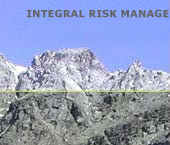| |
The risk-related characteristics of debris flows, rock avalanches, and snow avalanches encompass a broad range of causative factors, trigger mechanisms,
processes and runout distances, as well as possible mitigation measures. While substantial work has been carried out to assess the
hazards and risks associated with each of these processes, no comprehensive
approach addressing the range of possible process combinations
in both space and time has yet been developed. IRASMOS was therefore
intended to steer the focus towards the holistic, i. e. Integral Risk Management of Extremely Rapid Mass Movements and away from mere
process-based research. Our research was not guided by individual natural
phenomena, but rather by finding effective ways to quantify and mitigate
the total risk from several phenomena on the basis of current knowledge.
The key objectives of the IRASMOS project were:
1. To critically review common practice in hazard and risk assessment of
debris flows, rock avalanches, and snow avalanches.
|
|
2. To evaluate the sensitivity of risk as a function of varying hazards, vulnerability, and elements at risk.
3. To discuss and quantify aspects of risk aversion.
4. To address cause-effect relationships between Extremely Rapid Mass
Movements and their off-site and long-term effects in a multi-risk approach.
5. To develop methodological tools for an Integral Risk Management (IRM)
paying equal attention to active and passive measures of prevention,
intervention, and recovery.
6. To propose IRM strategies for detecting, monitoring, and responding
to Extremely Rapid Mass Movements, given the constraints of data
quality, availability, and analysis, and especially given the limited allocation
of technical, logistical, and financial budgets.
>> Home |

